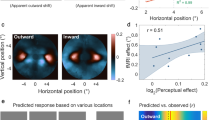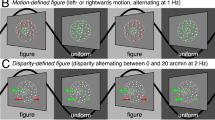Abstract
FUNCTIONAL magnetic resonance imaging (fMRI)1–3 was used to measure local haemodynamic changes (reflecting electrical activity) in human visual cortex during production of the visual motion aftereffect, also known as the waterfall illusion4,5. As in previous studies6–9, human cortical area MT (V5) responded much better to moving than to stationary visual stimuli. Here we demonstrate a clear increase in activity in MT when subjects viewed a stationary stimulus undergoing illusory motion, following adaptation to stimuli moving in a single local direction. Control stimuli moving in reversing, opposed directions produced neither a perceptual motion aftereffect nor elevated fMRI levels postadaptation. The time course of the motion aftereffect (measured in parallel psychophysical tests) was essentially identical to the time course of the fMRI motion aftereffect. Because the motion aftereffect is direction specific, this indicates that cells in human area MT are also direction specific. In five other retinotopically defined cortical areas, similar motion-specific aftereffects were smaller than those in MT or absent.
This is a preview of subscription content, access via your institution
Access options
Subscribe to this journal
Receive 51 print issues and online access
$199.00 per year
only $3.90 per issue
Buy this article
- Purchase on Springer Link
- Instant access to full article PDF
Prices may be subject to local taxes which are calculated during checkout
Similar content being viewed by others

References
Kwong, K. K. et al. Proc. natn. Acad. Sci. U.S.A. 89, 5675–5679 (1992).
Ogawa, S. et al. Proc. natn. Acad. Sci. U.S.A. 89, 5951–5955 (1992).
Bandettini, P. A., Wong, E. C., Hinks, R. S., Tikofsky, R. S. & Hyde, J. S. Magn. Reson. Med. 25, 390–397 (1992).
Adams, R. Phil. Mag. 5, 373–374 (1834).
Wohlgemuth, A. Br. J. Psychol. (Suppl.) 1, 1–117 (1911).
Zeki, S. et al. J. Neurosci. 11, 641–649 (1991).
Watson, J. D. G. et al. Cerebr. Cort. 3, 79–94 (1993).
Dupont, P., Orban, G. A., DeBruyn, B., Verbruggen, A. & Mortelmans, L. J. Neurophysiol. 72, 1420–1424 (1994).
Tootell, R. B. H. et al. J. Neurosci. 15, 3215–3230 (1995).
Clarke, S. & Miklossy, J. J. comp. Neurol. 298, 188–214 (1990).
Tootell, R. B. H. & Taylor, J. B. Cerebr. Cort. 5, 39–55 (1995).
Petersen, S. E., Baker, J. F. & Allman, J. M. Brain Res. 346, 146–150 (1985).
Barlow, H. B. & Hill, R. M. Nature 200, 1345–1347 (1963).
Hammond, P., Mouat, G. S. V. & Smith, A. T. Expl Brain Res. 60, 411–416 (1985).
Marlin, S. G., Sohail, S. J., Hasan, J. & Cynader, M. S. J. Neurophysiol. 59, 1314–1330 (1988).
Movshon, J. A. & Lennie, P. Nature 278, 850–852 (1979).
Vautin, R. G. & Berkeley, M. A. J. Neurophysiol. 40, 1051–1065 (1977).
Von der Heydt, R., Hanny, P. & Adorjani, C. Archs ital. Biol. 116, 248–254 (1978).
Carney, T. & Shadlen, M. N. Vision Res. 33, 1977–1995 (1993).
Schneider, W., Noll, D. C. & Cohen, J. D. Nature 365, 150–153 (1993).
DeYoe, E. A. et al. J. Neurosci. Meth. 54, 171–187 (1995).
Sereno, M. I. et al. Science (in the press).
Felleman, D. J. & Van Essen, D. C. Cerebr. Cort. 1, 1–47 (1991).
Nishida, S., Ashida, H. & Sato, T. Vision Res. 34, 2707–2716 (1994).
Nishida, S. & Sato, T. Vision Res. 32, 1635–1646 (1992).
Zeki, S., Watson, J. D. & Frackowiak, R. S. Proc. R. Soc. B252, 215–222 (1993).
Friston, K. J., Jezzard, P. & Turner, R. Hum. Brain Mapping 1, 153–171 (1994).
Born, R. T. & Tootell, R. B. H. Nature 357, 497–499 (1992).
Allman, J. M., Baker, J. F., Newsome, W. T. & Petersen, S. E. in Cortical Sensory Organization Vol. 2. Multiple Visual Areas (ed. Woolsey, C. N.) 171–185 (Humana, Clifton, NJ, 1981).
Lagae, L., Gulyas, B., Raiguel, S. & Orban, G. A. Brain Res. 496, 361–367 (1989).
Author information
Authors and Affiliations
Rights and permissions
About this article
Cite this article
Tootell, R., Reppas, J., Dale, A. et al. Visual motion aftereffect in human cortical area MT revealed by functional magnetic resonance imaging. Nature 375, 139–141 (1995). https://doi.org/10.1038/375139a0
Received:
Accepted:
Issue Date:
DOI: https://doi.org/10.1038/375139a0
This article is cited by
-
Amblyopia: progress and promise of functional magnetic resonance imaging
Graefe's Archive for Clinical and Experimental Ophthalmology (2023)
-
Optic flow selectivity in the macaque parieto-occipital sulcus
Brain Structure and Function (2021)
-
Intrinsic timescales of sensory integration for motion perception
Scientific Reports (2019)
-
Congruent audio-visual stimulation during adaptation modulates the subsequently experienced visual motion aftereffect
Scientific Reports (2019)
-
Differential cortical activation during the perception of moving objects along different trajectories
Experimental Brain Research (2019)
Comments
By submitting a comment you agree to abide by our Terms and Community Guidelines. If you find something abusive or that does not comply with our terms or guidelines please flag it as inappropriate.


